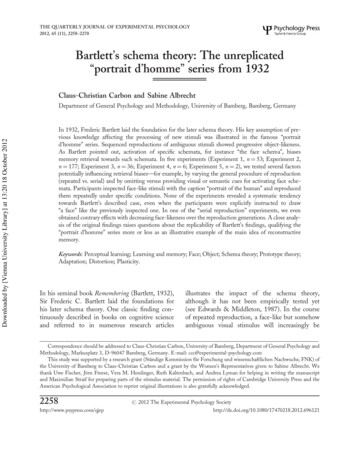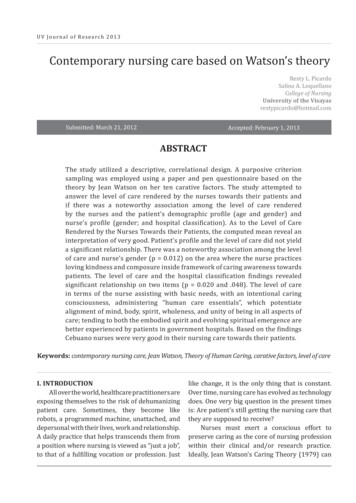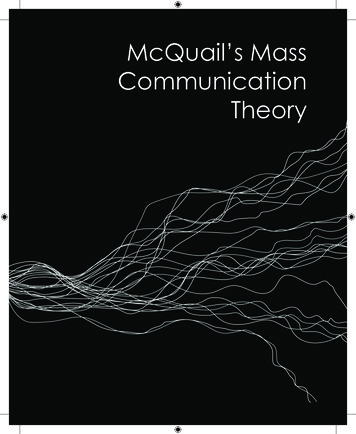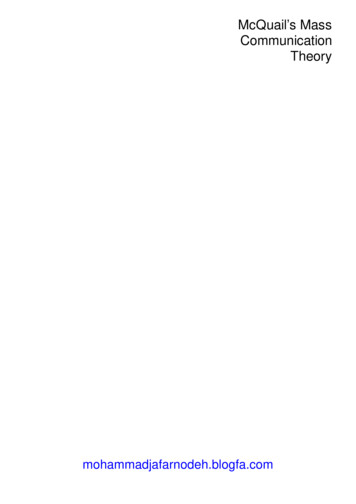
Transcription
THE QUARTERLY JOURNAL OF EXPERIMENTAL PSYCHOLOGY2012, 65 (11), 2258–2270Bartlett’s schema theory: The unreplicated“portrait d’homme” series from 1932Claus-Christian Carbon and Sabine AlbrechtDownloaded by [Vienna University Library] at 13:20 18 October 2012Department of General Psychology and Methodology, University of Bamberg, Bamberg, GermanyIn 1932, Frederic Bartlett laid the foundation for the later schema theory. His key assumption of previous knowledge affecting the processing of new stimuli was illustrated in the famous “portraitd’homme” series. Sequenced reproductions of ambiguous stimuli showed progressive object-likeness.As Bartlett pointed out, activation of specific schemata, for instance “the face schema”, biasesmemory retrieval towards such schemata. In five experiments (Experiment 1, n 53; Experiment 2,n 177; Experiment 3, n 36; Experiment 4, n 6; Experiment 5, n 2), we tested several factorspotentially influencing retrieval biases—for example, by varying the general procedure of reproduction(repeated vs. serial) and by omitting versus providing visual or semantic cues for activating face schemata. Participants inspected face-like stimuli with the caption “portrait of the human” and reproducedthem repeatedly under specific conditions. None of the experiments revealed a systematic tendencytowards Bartlett’s described case, even when the participants were explicitly instructed to draw“a face” like the previously inspected one. In one of the “serial reproduction” experiments, we evenobtained contrary effects with decreasing face-likeness over the reproduction generations. A close analysis of the original findings raises questions about the replicability of Bartlett’s findings, qualifying the“portrait d’homme” series more or less as an illustrative example of the main idea of reconstructivememory.Keywords: Perceptual learning; Learning and memory; Face; Object; Schema theory; Prototype theory;Adaptation; Distortion; Plasticity.In his seminal book Remembering (Bartlett, 1932),Sir Frederic C. Bartlett laid the foundations forhis later schema theory. One classic finding continuously described in books on cognitive scienceand referred to in numerous research articlesillustrates the impact of the schema theory,although it has not been empirically tested yet(see Edwards & Middleton, 1987). In the courseof repeated reproduction, a face-like but somehowambiguous visual stimulus will increasingly beCorrespondence should be addressed to Claus-Christian Carbon, University of Bamberg, Department of General Psychology andMethodology, Markusplatz 3, D-96047 Bamberg, Germany. E-mail: ccc@experimental-psychology.comThis study was supported by a research grant (Ständige Kommission für Forschung und wissenschaftlichen Nachwuchs; FNK) ofthe University of Bamberg to Claus-Christian Carbon and a grant by the Women’s Representatives given to Sabine Albrecht. Wethank Uwe Fischer, Jörn Freese, Vera M. Hesslinger, Ruth Kaltenbach, and Andrea Lyman for helping in writing the manuscriptand Maximilian Straif for preparing parts of the stimulus material. The permission of rights of Cambridge University Press and theAmerican Psychological Association to reprint original illustrations is also gratefully acknowledged.2258http://www.psypress.com/qjep# 2012 The Experimental Psychology 121
Downloaded by [Vienna University Library] at 13:20 18 October 2012BARTLETT’S SCHEMA THEORYFigure 1. Original illustration of the “portrait d ’homme” series by Bartlett (1932) often found in text books of cognitive psychology. Thenaming of the depiction (“portrait d ’homme”) was always reproduced. From Remembering: A Study in Experimental and SocialPsychology (pp. 178–179), by F. C. Bartlett, 1932, Cambridge, UK: Cambridge University Press. Copyright 1932 by CambridgeUniversity Press. Reprinted with permission.changed towards a simple and prototypical face.Figure 1 shows the original picture series consistingof one original (Original Drawing) and nine successive reproductions (1–9).Bartlett noted a couple of characteristics of thedevelopment of reproduction. The most importantcharacteristic was that drawings became more andmore face-like. Additionally, he observed the drawings becoming increasingly “simplified” and more“conventional” (Bartlett, 1932, p. 185). It is ofmajor importance that the caption (“portraitd’homme”) was continuously used for eachdrawing. Bartlett himself stressed that “in theearly experiments on perceiving it became clearthat the assignment of a name to objects observedoften strongly influenced their immediate reproduction or description” (Bartlett, 1932, p. 183).Pioneering work on this aspect was done byCarmichael, Hogen, and Walter (1932) whodemonstrated that the mere naming of an ambiguous stimulus directs the observer’s interpretationtowards the representation activated by thecaption of the stimulus (see Figure 2).These effects have been replicated in variousdomains—for instance, even understanding andappreciation of art are modulated by entitling theartwork (Leder, Carbon, & Ripsas, 2006). Wewould like to summarize this factor as the“naming hypothesis”. Other factors influencingspecific schemata might be the delay betweeninspection and reproduction of stimuli (seeWheeler & Roediger, 1992), the context andinstruction during both phases (von Hippel,Jonides, Hilton, & Narayan, 1993), and the specifickind of reproduction technique—for example,“repeated reproduction”, during which peoplehave to reproduce their own reproduction againand again, or “serial reproduction” (see Bartlett,1932), which follows the idea of Chinese whispers.Although Bartlett’s schema theory is clearly animportant part of the classic theories of cognitivepsychology and is obviously present in everydaylife experiences, empirical proof of his originalexperiments on remembering (Bartlett, 1932)using picture material is sparse, and paradigmshave not been replicated so far.Present studyIn the present study, we test several factors to identify key variables triggering schemata sensu Bartlett(1932), mainly the naming hypothesis. Therefore, wereplicated Bartlett’s methods of “repeated”(Experiments 1 and 5) and “serial reproduction”(Experiments 2, 3, and 4). In both experimentalprocedures, participants had to draw previouslyTHE QUARTERLY JOURNAL OF EXPERIMENTAL PSYCHOLOGY, 2012, 65 (11)2259
Downloaded by [Vienna University Library] at 13:20 18 October 2012CARBON AND ALBRECHTFigure 2. Illustration of the ambiguous stimuli used in the study of Carmichael, Hogen, and Walter (1932) (see in the centre) and someexamples of drawings evoked by different naming of the stimuli (see left and right). From “An Experimental Study of the Effect ofLanguage on the Reproduction of Visually Perceived Form”, by L. Carmichael, H. P. Hogen, and A. A. Walter, 1932, Journal ofExperimental Psychology, 15(1), p. 75. Copyright 1932 by the American Psychological Association. Reprinted with permission. Thematerial is now in the public domain.2260THE QUARTERLY JOURNAL OF EXPERIMENTAL PSYCHOLOGY, 2012, 65 (11)
Downloaded by [Vienna University Library] at 13:20 18 October 2012BARTLETT’S SCHEMA THEORYinspected sketches. In the repeated procedure, eachparticipant reproduced the same initial objectseveral times in a row, whereas participants in theserial procedure reproduced one single stimulus,and then the drawing was shown to another participant, who then had to reproduce it, and so on. Weemployed both procedures in one study to increaseexternal validity of the effects of the tested factorson the reproduction quality and direction. To testthe naming hypothesis, we omitted any explicitreference to faces in Experiments 1 and 2,whereas we made such a reference in Experiments3 and 4 and even biased participants towards facereproduction in a rather suggestive way inExperiment 5. To test the impact of delaybetween inspection of the pictures and reproduction, we implemented delays of 15 min, 24 hours,and one week, respectively. As we were also interested in the impact of initial face-likeness of thestimulus material, we varied this experimental variable on three and six levels, respectively.PRESTUDY A: ASSESSMENT OFFACE-LIKENESS OF BARTLETT’S“PORTRAIT D’HOMME” SERIESAs an initial test, we assessed the face-likeness ofBartlett’s (1932) “portrait d’homme” series,because it is not clear that an increasing face-likeness was indeed obtained by Bartlett. In fact, theface-likeness was never empirically evaluated.MethodParticipantsSeven students (undergraduates and graduates) ofthe University of Bamberg (2 female, mean age 29.6 years, range: 19–46 years) participated. Allof them were naïve to the purpose of the study.MaterialWe used the reproductions that were done in thefirst six (reproduction) sessions of Bartlett’s “portrait d’homme” series (Reproductions 1–6, seeFigure 1), which were obtained via “serial reproduction” (see details in the Procedure section ofTable 1. Prestudy A: Means and standard deviations of the facelikeness rating of the “portrait d’homme” seriesRatingSession 30.790.760.54Note: Ratings: 1 “not face-like at all”; 7 “very face-like”.Experiment 2). In contrast to Bartlett’s originaldrawing, we presented them without the caption“portrait d’homme” to avoid suggesting that thiswas the portrait of a human, which in this casewould be evidently very face-like.ProcedureParticipants evaluated one stimulus after another ina randomized order on a 7-point Likert scale(1 “not face-like at all” to 7 “very face-like”).There was no time limit for the evaluation.Results and discussionThe ratings are shown in Table 1.A one-way repeated measurement analysis ofvariance (ANOVA) with session number as awithin-subjects factor revealed a strong increase inface-likenessfromReproduction1toReproduction 6, F(5, 30) 29.86, p , .0001,η2p .833.PRESTUDY B: ASSESSMENT OFFACE-LIKENESS OF THE STIMULIAs the initial face-likeness seems to be an important variable for triggering face-specific “remembering processes” (sensu Bartlett, 1932), we variedthe face-likeness of new stimuli on a maximum ofsix levels. To validate our manipulation of face-likeness, in Prestudy B participants had to assess thisvariable.THE QUARTERLY JOURNAL OF EXPERIMENTAL PSYCHOLOGY, 2012, 65 (11)2261
CARBON AND ALBRECHTDownloaded by [Vienna University Library] at 13:20 18 October 2012Figure 3. Objects used as initial stimuli in Experiments 1–5. Object 1 is identical with the object that Bartlett (1932) used and showed in hisbook. Face-likeness scores are displayed based on the results of Prestudy B.MethodParticipantsSeven undergraduate students of the University ofBamberg (2 female, mean age 25.3 years, range:21–30 years) participated. All of them were naïveto the purpose of the study.MaterialWe used six more-or-less face-like pictures, ofwhich one (Figure 3, Object 1) was Bartlett’s(1932) original starting image of the “portraitd’homme” series. The other pictures were specifically created for the present study to ensure unfamiliarity of the stimulus material due to potentialdisplays of the original material in basic psychological courses. To ensure full compatibility betweenthe procedure of Bartlett’s studies and the presentstudy, we used the same subtitle (German:“Portrait des Menschen”, i.e. “portrait of thehuman”).ProcedureParticipants evaluated one stimulus after another ina randomized order on a 7-point Likert scale(1 “not face-like at all” to 7 “very face-like”)without a time limit.Results and discussionThe mean face-likeness values are displayed inFigure 3. The face-likeness ranged from very low(M 2.43) to very high (M 6.00) enabling us2262to test the impact of initial face-likeness on thequality of the subsequent process of reproduction.EXPERIMENT 1: REPEATEDREPRODUCTION WITHOUTEXPLICIT NAMINGThe major aim of Experiment 1 was to replicateBartlett’s original procedure of “repeated reproduction” (Bartlett, 1932) in the visual domain withoutexplicit naming.MethodParticipantsFifty-three undergraduates (49 female; mean age 21.4 years, range: 19–33 years) of the University ofBamberg participated for course credit. All of themwere naïve to the purpose of the study.MaterialWe used three pictures showing objects (Figure 3,Objects 1–3), which had been assessed withPrestudy B. Objects 4–6 were not used inExperiment 1 in order to reach a representativenumber of participants in the series for all initialobjects, due to typical increase of dropout withadvancing test session numbers.ProcedureWe used Bartlett’s method of “repeated reproduction” described in Bartlett (1932, chapter 9). TheTHE QUARTERLY JOURNAL OF EXPERIMENTAL PSYCHOLOGY, 2012, 65 (11)
Downloaded by [Vienna University Library] at 13:20 18 October 2012BARTLETT’S SCHEMA THEORYparticipants were randomly assigned to one of threegroups, each inspecting a different object forapproximately 30 s. After inspection, they completed a cover task lasting about 15 min. Theythen received the following instruction: “Pleasedraw the picture as accurately as you can rememberit.” After a delay of one week, they were againinstructed to draw the initial object as accuratelyas they could remember it. We repeated this procedure five more times with a delay of one weekbetween two consecutive sessions.To measure the face-likeness of the producedmaterial, 7 participants (3 female; mean age 22.3 years, range: 20–28 years) from a differentsample from the experimental group rated thedegree of face-likeness of the drawings on a 7point Likert scale (1 “not face-like at all” to7 “very face-like”).Results and discussionBartlett (1932) based his description of the schematheory on the observation of successively increasingobject-(face-)likeness resulting from ambiguousstimuli as initial stimuli. In consequence, thedependent variable of interest in the present studyis face-likeness. We analyzed the corresponde
THE QUARTERLY JOURNAL OF EXPERIMENTAL PSYCHOLOGY, 2012, 65 (11) 2261 BARTLETT’S SCHEMA THEORY Downloaded by [Vienna University Library] at 13:20 18 October 2012 . Method Participants Seven undergraduate students of the University of Bamberg (2 female, mean age 25.3 years, range: 21–30 years) participated. All of them were naïve to the purpose of the study. Material











